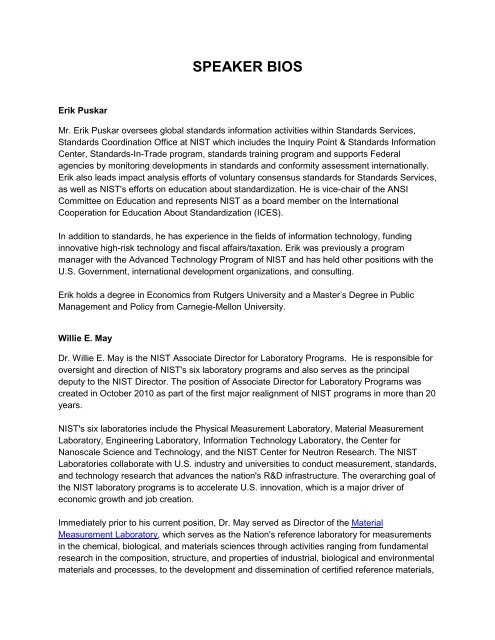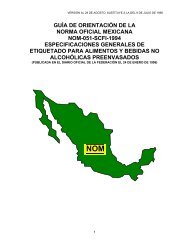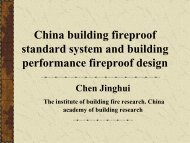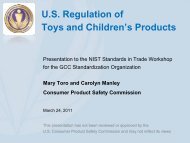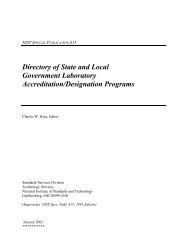SPEAKER BIOS - NIST Global Standards Information Home
SPEAKER BIOS - NIST Global Standards Information Home
SPEAKER BIOS - NIST Global Standards Information Home
Create successful ePaper yourself
Turn your PDF publications into a flip-book with our unique Google optimized e-Paper software.
Erik Puskar<br />
<strong>SPEAKER</strong> <strong>BIOS</strong><br />
Mr. Erik Puskar oversees global standards information activities within <strong>Standards</strong> Services,<br />
<strong>Standards</strong> Coordination Office at <strong>NIST</strong> which includes the Inquiry Point & <strong>Standards</strong> <strong>Information</strong><br />
Center, <strong>Standards</strong>-In-Trade program, standards training program and supports Federal<br />
agencies by monitoring developments in standards and conformity assessment internationally.<br />
Erik also leads impact analysis efforts of voluntary consensus standards for <strong>Standards</strong> Services,<br />
as well as <strong>NIST</strong>'s efforts on education about standardization. He is vice-chair of the ANSI<br />
Committee on Education and represents <strong>NIST</strong> as a board member on the International<br />
Cooperation for Education About Standardization (ICES).<br />
In addition to standards, he has experience in the fields of information technology, funding<br />
innovative high-risk technology and fiscal affairs/taxation. Erik was previously a program<br />
manager with the Advanced Technology Program of <strong>NIST</strong> and has held other positions with the<br />
U.S. Government, international development organizations, and consulting.<br />
Erik holds a degree in Economics from Rutgers University and a Master’s Degree in Public<br />
Management and Policy from Carnegie-Mellon University.<br />
Willie E. May<br />
Dr. Willie E. May is the <strong>NIST</strong> Associate Director for Laboratory Programs. He is responsible for<br />
oversight and direction of <strong>NIST</strong>'s six laboratory programs and also serves as the principal<br />
deputy to the <strong>NIST</strong> Director. The position of Associate Director for Laboratory Programs was<br />
created in October 2010 as part of the first major realignment of <strong>NIST</strong> programs in more than 20<br />
years.<br />
<strong>NIST</strong>'s six laboratories include the Physical Measurement Laboratory, Material Measurement<br />
Laboratory, Engineering Laboratory, <strong>Information</strong> Technology Laboratory, the Center for<br />
Nanoscale Science and Technology, and the <strong>NIST</strong> Center for Neutron Research. The <strong>NIST</strong><br />
Laboratories collaborate with U.S. industry and universities to conduct measurement, standards,<br />
and technology research that advances the nation's R&D infrastructure. The overarching goal of<br />
the <strong>NIST</strong> laboratory programs is to accelerate U.S. innovation, which is a major driver of<br />
economic growth and job creation.<br />
Immediately prior to his current position, Dr. May served as Director of the Material<br />
Measurement Laboratory, which serves as the Nation's reference laboratory for measurements<br />
in the chemical, biological, and materials sciences through activities ranging from fundamental<br />
research in the composition, structure, and properties of industrial, biological and environmental<br />
materials and processes, to the development and dissemination of certified reference materials,
critically evaluated data, and other measurement quality assurance programs. Dr. May’s<br />
personal research was focused in the areas of trace organic chemical analysis and the<br />
determination of physico-chemical properties of organic compounds.<br />
Dr. May has several leadership responsibilities in addition to those at <strong>NIST</strong>. Among those are<br />
his serving as Vice President of the 18-person International Committee on Weights and<br />
Measures (CIPM); his serving as President of CIPM’s Consultative Committee on Metrology in<br />
Chemistry and Biology; and his serving on the Board of Advisors to Japan’s National Institute of<br />
Advanced Industrial Science and Technology.<br />
James Olthoff<br />
Dr. James Olthoff is the Deputy Director of the Physical Measurement Laboratory of the<br />
National Institute of <strong>Standards</strong> and Technology (<strong>NIST</strong>). As Deputy Director of PML, Jim is<br />
responsible for the realization of the fundamental units at <strong>NIST</strong> and for all related calibration<br />
services. Jim has worked at <strong>NIST</strong> since 1987 where he performed research related to electrical<br />
breakdown in gases of interest to the electric power and semiconductor industries, and<br />
performed calibrations of high voltage transformers and capacitors. In 2001 he became the<br />
Chief of the Quantum Electrical Metrology Division, which was the organization that maintains<br />
the fundamental electrical standards for the United States, until he was appointed Deputy<br />
Director of the Electronics and Electrical Engineering Laboratory in 2007.<br />
Jim received his Ph.D. in physics from the University of Maryland in 1985 in the area of atomic<br />
and molecular physics. He then held a two-year appointment at The Johns Hopkins School of<br />
Medicine before being hired by <strong>NIST</strong>. Jim has published over 120 publications and has coauthored/edited<br />
four books. His international metrology responsibilities include serving as the<br />
Chair of the Sistema Interamericano de Metrologia (SIM) Quality System Task Force (QSTF),<br />
representing SIM on the Joint Committee of the Regional Metrology Organizations (JCRB),<br />
serving as the Chair of the Conference on Precision Electromagnetic Measurements, and<br />
representing <strong>NIST</strong> on the Consultative Committee on Electricity and Magnetism. Jim also<br />
serves as the <strong>NIST</strong> representative to the Boards of the NCSL International and iNEMI.<br />
Robert L. Watters, Jr.<br />
Dr. Robert L. Watters, Jr. is the Associate Director for Measurement Services in the Material<br />
Measurement Laboratory (MML) at the National Institute of <strong>Standards</strong> and Technology (<strong>NIST</strong>).<br />
Dr. Watters is also the Director of the Office of Reference Materials (ORM) at the National<br />
Institute of <strong>Standards</strong> and Technology (<strong>NIST</strong>), a position he has held since 2004. Dr. Watters<br />
has over 36 years of experience at <strong>NIST</strong> in the development of Standard Reference Materials<br />
(SRMs) and international metrology comparisons.<br />
The Office of Reference Materials is responsible for all business support and information<br />
technology resources for <strong>NIST</strong>'s Standard Reference Material Program. ORM also provides IT<br />
support for <strong>NIST</strong> calibration services. These programs represent over twenty million dollars in
the transfer of <strong>NIST</strong> measurement services to the public and government agencies around the<br />
world.<br />
Dr. Watters received his B.S. in Chemistry from the University of Notre Dame in 1970 and his<br />
Ph.D. in Analytical Chemistry from the University of Wisconsin in 1976. He joined the National<br />
Bureau of <strong>Standards</strong> in 1976, and became Group Leader for Atomic and Molecular<br />
Spectrometry in 1987. He has participated in the analysis and certification of over 150 Standard<br />
Reference Materials. He was a member of the <strong>NIST</strong> Ad Hoc Committee on Uncertainty<br />
Statements, which developed the <strong>NIST</strong> policy on implementing the ISO Guide to Uncertainty in<br />
Measurement.<br />
Dr. Watters was a founding member of the Comité International des Poids et Mesures (CIPM)<br />
Consultative Committee on Amount of Substance. He led a team that developed an<br />
international database system for comparison measurements performed by the world's National<br />
Metrology Institutes. He is also responsible for maintaining the <strong>NIST</strong> Traceability web site,<br />
wherein the <strong>NIST</strong> policy on traceability is articulated, and through which many of <strong>NIST</strong>’s<br />
customers obtain answers to their traceability questions.<br />
Carol Hockert<br />
Ms. Carol Hockert is the Chief of the Office of Weights and Measures at <strong>NIST</strong>, which provides<br />
technical expertise, training, international perspective and representation, and oversight to the<br />
U.S. legal metrology infrastructure. As part of her responsibilities, she serves as the Executive<br />
Secretary for the National Conference on Weights and Measures.<br />
Prior to her appointment at <strong>NIST</strong>, she was the Director of the Weights and Measures Division<br />
for the State of Minnesota. Ms. Hockert began her career as a metrologist in the Minnesota<br />
state metrology laboratory, where she gained experience in mechanical, dimensional and<br />
thermodynamic calibrations, as well as in technical writing. She has done technical training on<br />
several measurement topics. In addition, she spent six years as a both a lead and technical<br />
assessor for the National Voluntary Laboratory Accreditation Program (NVLAP).<br />
Ms. Hockert is currently the Technical Program chair for the NCSL International (NCSLI), a<br />
professional association made up of people and organizations with an interest in measurement<br />
science. She is also a Past President. NCSLI promotes competitiveness and success of its<br />
members by improving the quality of products and services through excellence in calibration,<br />
testing, and metrology education and training.<br />
Ms. Hockert received her Bachelor of Chemical Engineering degree from the University of<br />
Minnesota in 1983.
Michael D. Hogan<br />
Mr. Michael D. Hogan has worked as an electronics engineer at the National Institute of<br />
<strong>Standards</strong> and Technology (<strong>NIST</strong>) since 1974. As the <strong>Standards</strong> Liaison for the <strong>NIST</strong><br />
<strong>Information</strong> Technology Laboratory, he represents <strong>NIST</strong> at national and international fora that<br />
advance measurement science, testing, and standards in support of more interoperable, usable,<br />
scalable, reliable, and secure <strong>Information</strong> and Communications Technologies (ICT). Since<br />
September 2003, Mr. Hogan has served as the Convener of the international standards group:<br />
ISO/IEC JTC 1/SC 37 Working Group 4 - Biometric Functional Architecture and Related<br />
Profiles. From February 2007 to November 2012, Mr. Hogan served as the Co-Chair and then<br />
Chair of the <strong>Standards</strong> and Conformity Assessment Working Group of the NSTC Subcommittee<br />
on Biometrics and Identity Management. Mr. Hogan is also serving as the Co-Convener of the<br />
public <strong>NIST</strong> Cloud Computing <strong>Standards</strong> Roadmap Working Group, which was established in<br />
January 2011.<br />
Mr. Hogan graduated with honors (member of Eta Kappa Nu) with a B.S. degree in electrical<br />
engineering from the University of Maryland in 1973. In 1967, he was a Distinguished Graduate<br />
of the Infantry Officer Candidate School at Fort Benning, Georgia. During 1968 and 1969,<br />
Lieutenant Hogan served in Vietnam as an executive officer, an operations officer, and a<br />
platoon leader for U.S. Army units attached to the 199th Light Infantry Brigade and to the 1st<br />
Infantry Division.<br />
Sally Bruce<br />
Ms. Sally Bruce is currently the Quality Manager for <strong>NIST</strong> Measurement Services: Calibrations<br />
and Standard Reference Materials. Ms. Bruce has developed, documented, implemented, and<br />
managed quality systems for specific <strong>NIST</strong> measurement service areas since 1992. She<br />
previously served as the Chief of the National Voluntary Laboratory Accreditation Program<br />
(NVLAP) from 2006-2011.<br />
Ms. Bruce's career at <strong>NIST</strong>, formerly NBS, has spanned 30 years and her responsibilities and<br />
experience is vast and includes generic technical and more specific engineering in the fields of<br />
electrical and mechanical, electromagnetics, vacuum technology, particle physics,<br />
thermodynamics and heats of combustion, a variety of research and development efforts, and<br />
calibrations in the discipline of optical radiation. Her experiences as a physical scientist have<br />
included responsibilities for measurement science, quality management, technical editing and<br />
writing for various publications and media, teaching and presenting information and research,<br />
project management for a variety of laboratory activities and infrastructure including information<br />
technology and website management.<br />
She has actively participated as a member of the task force committees at <strong>NIST</strong> for the<br />
development of the Quality Manual for Measurement Services (<strong>NIST</strong> QM-I). She organizes,<br />
plans, coordinates, and participates in the on-going assessments of the quality systems for the
<strong>NIST</strong> divisions that provide measurement services. She is responsible for assuring the overall<br />
implementation of the <strong>NIST</strong> Quality System and its conformance to ISO standards.<br />
Ms. Bruce joined the Calibration Program staff of the National Voluntary Laboratory<br />
Accreditation Program in the fall of 2003. As a Program Manager she was involved with many<br />
of the aspects of the laboratory accreditation process.<br />
Ms. Bruce is the official <strong>NIST</strong> representative to the System Interamericana de Metrologia (SIM-<br />
Spanish for Inter-American Metrology System) Quality System Task Force (QSTF). SIM is the<br />
regional metrology organization for the Americas. Ms. Bruce is also active in the International<br />
Laboratory Accreditation Cooperation (ILAC) and in the regional cooperatives as well, and is a<br />
member of the ILAC committee on accreditation issues specific to calibrations. She is a qualified<br />
lead assessor for the ISO 9000 series of quality management systems and is a peer evaluator<br />
for accreditation bodies with emphasis in calibration accreditations throughout Asia Pacific<br />
(APLAC) and a lead peer evaluator the Americas (IAAC) using the ISO/IEC 17011, the standard<br />
used for conformity assessment bodies.<br />
Her formal education began with an Associate in Arts Degree in Electromechanical Technology<br />
from Montgomery College in Maryland. She has since earned both Bachelor of Science and<br />
Master of Science degrees in Technology Management from the University of Maryland<br />
University College. She is also a certified professional in IT Management and Project<br />
Management.<br />
David Wollman<br />
Dr. David Wollman is one of <strong>NIST</strong>’s smart grid team leads, managing <strong>NIST</strong>’s smart grid<br />
standards and research efforts and overseeing Smart Grid Interoperability Panel activities.<br />
Before joining the Smart Grid and Cyber-physical Systems Program in the <strong>NIST</strong> Engineering<br />
Laboratory, he managed efforts within the Physical Measurement Laboratory to maintain and<br />
advance the Nation’s electrical standards and metrology supporting the electric power industry.<br />
He has worked closely with a variety of standards development organizations, and he is the<br />
<strong>NIST</strong> official representative on the Board of Directors at the North American Energy <strong>Standards</strong><br />
Board (NAESB), an ANSI-accredited SDO whose standards are often referenced by the Federal<br />
Energy Regulatory Commission (FERC). In addition, he has served in several other positions at<br />
<strong>NIST</strong>, including Scientific Advisor in the Electronics and Electrical Engineering Laboratory,<br />
Program Analyst in the <strong>NIST</strong> Director's Program Office, and bench-level scientist in Boulder,<br />
Colorado developing advanced high-resolution x-ray detectors.<br />
Before joining <strong>NIST</strong>, Dr. Wollman received his Ph.D. from the University of Illinois at Urbana-<br />
Champaign in the areas of superconducting electronics and device micro/nanofabrication. He<br />
has given numerous invited talks at international conferences, and holds three U.S. patents. He<br />
has received many awards, including the U.S. Department of Commerce Gold Medal and the<br />
<strong>NIST</strong> Applied Research Award.
Bert Coursey<br />
Dr. Bert Coursey is a Guest Researcher in the <strong>NIST</strong> <strong>Standards</strong> Services Group. He is also the<br />
Chairman of the ISO Strategic Advisory Group on Security. He joined the National Institute of<br />
<strong>Standards</strong> and Technology (<strong>NIST</strong>) (formerly the National Bureau of <strong>Standards</strong>) in 1972 and for<br />
the following 15 years worked on radioactivity standards for environmental radioactivity and<br />
nuclear medicine. More recently he has held management positions in radiation dosimetry and<br />
served as Chief of the Ionizing Radiation Division in the <strong>NIST</strong> Physics Laboratory.<br />
From 2003 to 2011, Dr. Coursey was on assignment to the U.S. Department of <strong>Home</strong>land<br />
Security (DHS) as Chief of the Office of <strong>Standards</strong> in the Science & Technology Directorate. In<br />
2004 he was appointed the <strong>Standards</strong> Executive for the Department. His office was responsible<br />
for the design and implementation of a national program for standards for homeland security. A<br />
partial listing of the DHS standards projects includes performance standards and testing and<br />
evaluation protocols for chemical, biological and radiological/nuclear detectors for emergency<br />
responders, explosives detection equipment, standards for preparedness, critical infrastructure<br />
protection, emergency management and resilience, and performance standards for information<br />
technology (IT) to include credentialing, biometrics and cyber security.<br />
Dr. Coursey is a recipient of the Bronze (1987), Silver (1997) and Gold (2002) Medals of the<br />
Department of Commerce. He is also a recipient of the Allen V. Astin Award and the Edward<br />
Bennet Rosa Award of the <strong>NIST</strong>. He is a past president of the International Committee for<br />
Radionuclide Metrology, and a Fellow of the American Association of Physicists in Medicine and<br />
the <strong>Standards</strong> Engineering Society. Dr. Coursey has over ninety publications on radioactivity<br />
standards and applied radiation dosimetry and has served for 35 years as editor of the journal<br />
Applied Radiation and Isotopes. Dr. Coursey received his B.S. degree in Chemistry in 1965, and<br />
the Ph.D. in Physical Chemistry in 1970, from the University of Georgia.<br />
Cameron Miller<br />
Dr. Cameron Miller is a research chemist with the National Institute of <strong>Standards</strong> and<br />
Technology. He joined <strong>NIST</strong> in 1996, to work in the fields of Photometry and Retroreflection<br />
and in 2003 was appointed the Photometry Project Leader. His research areas include all<br />
aspects of Photometry, Retroreflection, Measurement Uncertainty and Vision Science applied to<br />
lighting.<br />
Cameron is active in standards organization and committees, such as IES – Testing Procedure<br />
Committee (SSL Committee Chairman), CIE (USA voting member for Div 2), CIEUSA<br />
(Technical Vice President), ANSI/ISO TAG (Vice Chairman) and ASTM, and professional<br />
societies such as ISCC, NEMA, and CORM.<br />
He is also involved in the National Voluntary Laboratory Accreditation Program as an assessor<br />
for the Energy Efficient Lighting Program and the Calibration Program.<br />
Cameron Miller obtained his PhD in Physical Chemistry from Cornell University (1994).
Michael Garris<br />
Mr. Michael D. Garris is a computer scientist at <strong>NIST</strong> where he has worked for the last 26<br />
years. He is manager of ITL’s Image Group, renowned for its Research, Development, Test,<br />
and Evaluation programs in fingerprint, face, and iris biometrics. He has been working in the<br />
area of biometrics since 1998 and prior to that invested ten years working in the area of hand<br />
print recognition.<br />
Mr. Garris received a M.S. in Computer Science with a focus on artificial intelligence and image<br />
processing from Johns Hopkins University in 1991.<br />
Chiara (Clarissa) F. Ferraris<br />
Dr. Chiara (Clarissa) F. Ferraris is a physicist in the Inorganic Materials Group of the Materials<br />
and Structural Systems Division (MSSD) of the Engineering Laboratory (EL) at the National<br />
Institute of <strong>Standards</strong> and Technology (<strong>NIST</strong>). Dr. Ferraris joined the Inorganic Building<br />
Materials Group of the Materials and Construction Research Division in January 1994. She is<br />
carrying out studies on rheology of concrete, sorption measurements (Developed the ASTM<br />
standard test C 1585), and sulfate attack in concrete (proposed test under consideration by<br />
ASTM). In the field of cement particles size distribution measurements, she took the lead to<br />
provide the cement industry with a reference material for particle size distribution, SRM 114q<br />
and 46h and proposed a standard test method to AASHTO. Dr. Ferraris has published more<br />
than 100 papers.<br />
The main thrust of her work is on the rheological properties of fresh concrete. She was<br />
instrumental as chair of ASTM C01.22, workability, to develop two new standard tests and she<br />
is currently developing a granular reference material for mortar and concrete rheometers, based<br />
on the newly developed SRM 2492 for paste.<br />
From May 1987 to December 1993, prior to joining <strong>NIST</strong>, Dr. Ferraris was a Research Physicist<br />
at the Washington Research Center of W.R. Grace & Co., in Columbia, Maryland. From March<br />
1980 to April 1987, Dr. Ferraris worked at the Swiss Federal Institute of Technology in<br />
Lausanne, Switzerland with Professor Wittmann and carried out studies on shrinkage of cement<br />
and concrete. This research led to a Ph.D. thesis completed in 1986.<br />
Dr. Ferraris is a Fellow of the American Concrete Institute (ACI) since 2003 (member since<br />
1991). Also, she is involved in ASTM as the sub-chair of the ASTM committee Workability<br />
(C01.22) and the secretary of the ASTM committee on Sulfate Resistance (C01.29).<br />
Awards: In 2008, Dr. Ferraris received the Delmar L. Bloem Distinguished Service Award" from<br />
ACI for outstanding leadership in ACI 236 and 238. She is the recipient of the 2001 BFRL<br />
Communication Award for her report on the "Comparison of Concrete Rheometers International
tests of LCPC (Nantes, France) in October 2000." She also received in 2002 and 2008 "<strong>NIST</strong><br />
Equal Employment Opportunity/Diversity Award" for consistently encouraging careers in science<br />
and engineering for women.<br />
Michael Unterweger<br />
Dr. Michael Unterweger is the leader of the Radioactivity Group in the Radiation and<br />
Biomolecular Physics Division of the National Institute of <strong>Standards</strong> and Technology’s (<strong>NIST</strong>)<br />
Physical Measurement Laboratory, currently working on radionuclide metrology, internal gas<br />
counting, nuclear data parameters, and homeland security instrumentation testing.<br />
He has had extensive experience in the development of national and international standards<br />
through ANSI and IEC. He is acting as coordinator for the development of ANSI standards for<br />
radiation detection instrumentation for homeland security. He is a member of ASTM, ANSI,<br />
IEEE, IEC, and NCRP. His research includes radioactivity, internal gas counting, ionization<br />
chambers, microcomputers, micro-calorimetry, and alpha-particle counting.<br />
Before coming to <strong>NIST</strong>, he worked for five years on a Graduate Research Fellowship at Saint<br />
Louis University. In 2003, Unterweger received a Silver Medal from the Department of<br />
Commerce for his work on standards for the Department of <strong>Home</strong>land Security. He has coauthored<br />
43 publications.<br />
Michael Unterweger received a Ph.D. in nuclear physics from Saint Louis University and a B.S.<br />
in nuclear physics from the University of Buffalo.<br />
John R. Sieber<br />
Dr. John Sieber is an analytical chemist in the Chemical Sciences Division of the <strong>NIST</strong> Material<br />
Measurement Laboratory. Dr. Sieber works with the alloys and cement industries to develop<br />
standards, practices and guides for analyses of metals, ores and cement. Dr. Sieber is<br />
Technical Contact for approximately 320 <strong>NIST</strong> Standard Reference Materials for these<br />
industries and more. John is also active in standards and reference materials development for<br />
declarable substances in materials, including working with the U.S. Consumer Product Safety<br />
Commission on analyses of children’s products. Dr. Sieber specializes in X-ray fluorescence<br />
spectrometry, and has contributed elemental analyses for hundreds of <strong>NIST</strong> Standard<br />
Reference Materials, and he is developing a research program in quantitative speciation using<br />
X-ray absorption spectroscopy.<br />
Dr. Sieber received his Ph.D. from the University of Maryland in the area of quantitative surface<br />
analysis while working at <strong>NIST</strong>. John spent nine years in the petroleum industry supporting<br />
product development research and manufacturing of fuels and lubricants. He returned to <strong>NIST</strong><br />
in 1997 to run the XRF laboratory of the Inorganic Chemical Metrology Group. He has given<br />
numerous invited talks at international conferences, and consults with commercial reference
producers to leverage <strong>NIST</strong> SRMs. John has received awards from standards committees,<br />
including the ASTM International B. F. Scribner Award, and at <strong>NIST</strong>, including the U.S.<br />
Department of Commerce Bronze Medal.<br />
Gordon Gillerman<br />
Mr. Gordon Gillerman, Chief of <strong>Standards</strong> Services at the National Institute of <strong>Standards</strong> and<br />
Technology (<strong>NIST</strong>), coordinates and advises federal agencies, US industry and other<br />
stakeholders on standards and conformity assessment policy. <strong>Standards</strong> Services operates the<br />
U.S. Inquiry Point for the World Trade Organization’s Technical Barriers to Trade Agreement<br />
and is a key information source for US industry on standards related market access issues.<br />
Gordon has extensive experience coordinating standards policy and development across a wide<br />
range of critical issues in the U.S. including cloud computing, health IT, homeland security,<br />
safety, and health and protection of the environment. Gordon is the Public Sector Co-Chair of<br />
the American National <strong>Standards</strong> Institute’s (ANSI) <strong>Home</strong>land Security <strong>Standards</strong> Panel, an<br />
expert on conformity assessment systems and their nexus with regulatory and trade issues and<br />
a sought-after lecturer on standards, conformity assessment and regulation.<br />
Prior experience includes leading government affairs for the largest U.S. product safety<br />
certification and standard development organization, Underwriters Laboratories (UL) in<br />
Washington, DC, and Staff Engineer for the medical device and information technology sectors<br />
at UL’s Northbrook, IL headquarters.<br />
Gordon has worked collaboratively within the standards community to enhance health, safety,<br />
the environment and security throughout his career. In 2008 he received an Environmental<br />
Protection Agency Gold Medal, a Department of Commerce Bronze Medal and the ANSI<br />
Meritorious Service Award. In 2010 Gordon received a Department of Commerce Gold Medal<br />
for leadership in enhancing the performance standards and certification program for law<br />
enforcement body armor and EPA’s Award for Outstanding Leadership in Collaborative<br />
Problem-Solving for his work in guiding the development of a Green Clean-Up standard. In 2012<br />
Gordon received the ANSI Gerald H. Ritterbusch Conformity Assessment Medal.<br />
Gordon received a Bachelor's Degree in Electrical Engineering Technology from Bradley<br />
University in Peoria, IL.


